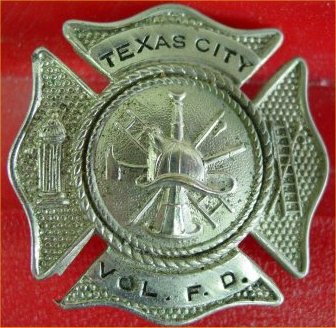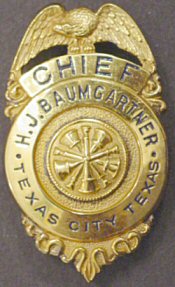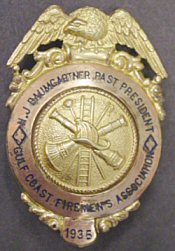The Texas City
Disaster
April
16, 1947
The morning of
16 April 1947 dawned clear and crisp, cooled by a brisk north
wind. Just before 8:00 A.M., longshoremen removed the hatch covers
on Hold 4 of the French Liberty ship Grandcamp as they
prepared to load the remainder of a consignment of ammonium nitrate
fertilizer. Some 2,300 tons were already onboard, 880 of which
were in the lower part of Hold 4. The remainder of the ship's
cargo consisted of large balls of sisal twine, peanuts, drilling
equipment, tobacco, cotton, and a few cases of small ammunition.
No special safety precautions were in focus at the time.
Several longshoremen descended into the hold and waited for the
first pallets holding the 100-pound packages to be hoisted from
dockside. Soon thereafter, someone smelled smoke. A plume was
observed rising between the cargo holds and the ships hull, apparently
about seven or eight layers of sacks down. Neither a gallon jug
of drinking water nor the contents of two fire extinguishers supplied
by crew members seemed to do much good. As the fire continued
to grow, someone lowered a fire hose, but the water was not turned
on. Since the area was filling fast with smoke, the longshoremen
were ordered out of the hold.
While Leonard Boswell, the gang foreman, and Peter Suderman, superintendent
of stevedores, discussed what action to take, the master, or captain,
of the Grandcamp appeared and stated in intelligible English
that he did not want to put out the fire with water because it
would ruin the cargo. Instead, he elected to suppress the flames
by having the hatches battened and covered with tarpaulins, the
ventilators closed, and the steam system turned on. At the masters
request, stevedores started removing cases of small arms ammunition
from Hold 5 as a precautionary measure. As the fire grew, the
increased heat forced the stevedores and some crew members to
leave the ship. The Grandcamp's whistle sounded an alarm
that was quickly echoed by the siren of the Texas City Terminal
Railway Company. despite a strike by the telephone workers, Suderman,
seriously concerned by now, managed to reach the Fire Department
and then called Galveston for a fire boat.
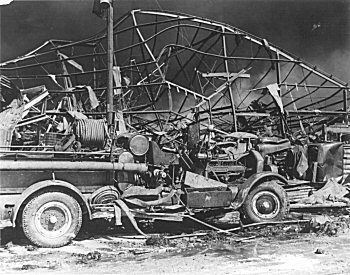
Remains of a city
fire truck |
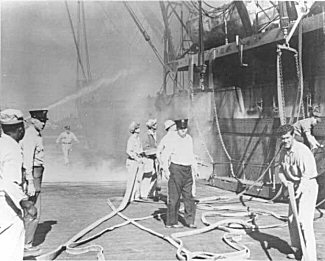
One of the last photographs
taken of the Texas City Volunteer Fire Department crew before the explosion.
Marion "Jack" Donnis Westmorland with hard hat on directly behind the Chief.
Fire Chief Buamgartner center with hat on.
|
It was now about
8:30. At this point, growing pressure from the compressed steam
fed into Hold 4 blew off the hatch covers, and a thick column
of orange smoke billowed into the morning sky. Attracted by its
unusual color and the sirens, several hundred onlookers began
gathering a few hundred feet away at the head of the ship. Twenty-six
men and the four trucks of the Volunteer Fire Department, followed
by the Republic Oil Refining Company fire-fighting team, arrived
on the scene and set up their hoses. A photograph taken at approximately
8:45 shows at least one stream playing on the deck of the Grandcamp,
which was apparently hot enough to vaporize the water.
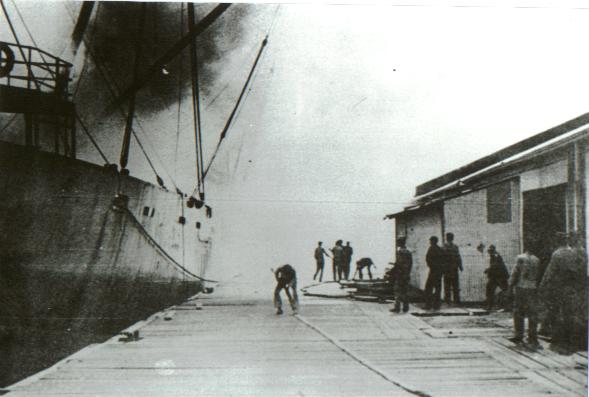
Firefighters spraying
water on Grandcamps deck |
Around 9:00, flames
erupted from the open hatch, with smoke variously described as
"a pretty gold, yellow color" or as "orange smoke
in the morning sunlight...beautiful to see." Twelve minutes
later, the Grandcamp disintegrated in a prodigious explosion
heard as far as 150 miles distant. A huge mushroom like cloud
billowed more than 2,ooo feet into the morning air, the shockwave
knocking two light planes flying overhead out of the sky. A thick
curtain of steel shards scythed through workers along the docks
and a crowd of curious onlookers who had gathered at the head
of the slip at which the ship was moored. Blast over pressure
and heat disintegrated the bodies of the firefighters and ship's
crew still on board. At the Monsanto plant, located across the
slip, 145 of 450 shift workers perished. A fifteen-foot wave of
water thrust from the slip by the force of the blast swept a large
steel barge ashore and carried dead and injured persons back into
the turning basin as it receded. Fragments of the Grandcamp,
some weighing several tons, showered down throughout the port
and town for several minutes, extending the range of casualties
and property damage well into the business district, about a mile
away. Falling shrapnel bombarded buildings and oil storage tanks
at nearby refineries, ripping open pipes and tanks of flammable
liquids and starting numerous fires. After the shrapnel, flaming
balls of sisal and cotton from the ships cargo fell out of the
sky, adding to the growing conflagration.
|
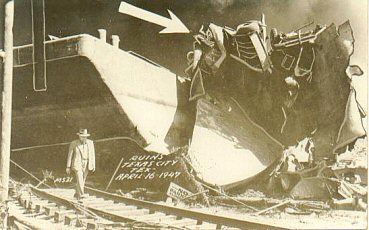
A man walks below the 150' LONGHORN
II that was washed ashore by the tidal wave created by the GRANDCAMP
exploding. The arrow points toward a destroyed city fire truck twisted
together with another vehicle and a large section of the GRANDCAMP.
This is from one of many post disaster postcards.
|
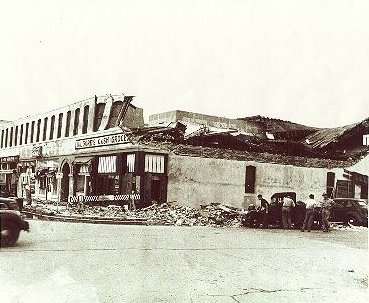
Downtown business |
The sheer power
of the explosion and the towering cloud of black smoke billowing
into the sky told everyone within twenty miles that something
terrible had happened. People on the street in Galveston were
thrown to the pavement, and glass store fronts shattered. Buildings
swayed in Baytown fifteen miles to the north. The towering smoke
column served as a grim beacon for motorists driving along the
Houston-Galveston highway, some of whom immediately turned toward
Texas City to help. In Texas City itself, stunned townspeople
who started toward the docks soon encountered wounded persons
staggering out of the swirling vortex of smoke and flame, most
covered with a thick coat of black, oily water. many agonizing
hours were to pass before a semblance of order began to replace
the shock and confusion caused by this totally unexpected and
devastating event.
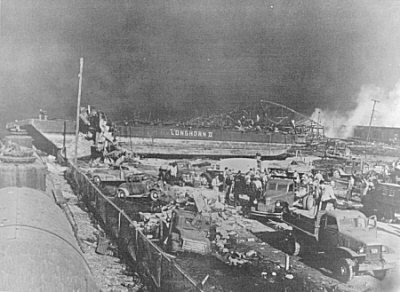
150ft barge LONGHORN II in background washed onshore
by tidal wave
|
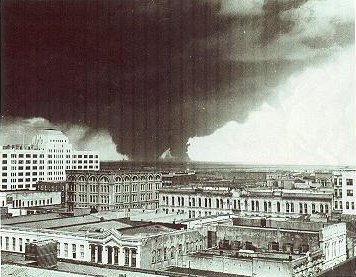
AS SEEN FROM ACROSS THE
BAY IN GALVESTON
|
As the surge of injured quickly
overwhelmed the towns three small medical clinics, the city auditorium was pressed
into service as a makeshift first-aid center. Within an hour doctors, nurses,
and ambulances began arriving unsummoned from Galveston and nearby military
bases. Serious casualties were taken to Galveston hospitals and later to military
bases and even to Houston, fifty miles away. State troopers and law enforcement
officers from nearby communities helped Texas City's seventeen-man police force
maintain order and assisted in search and rescue.
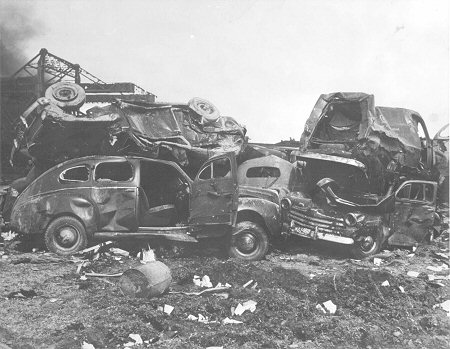 CARS PILED UP ON ONE ANOTHER
CARS PILED UP ON ONE ANOTHER |
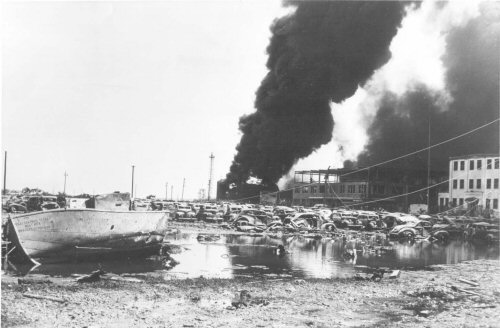 DESTROYED PARKING LOT AT MONSANTO CHEMICAL
COMPANY
DESTROYED PARKING LOT AT MONSANTO CHEMICAL
COMPANY |
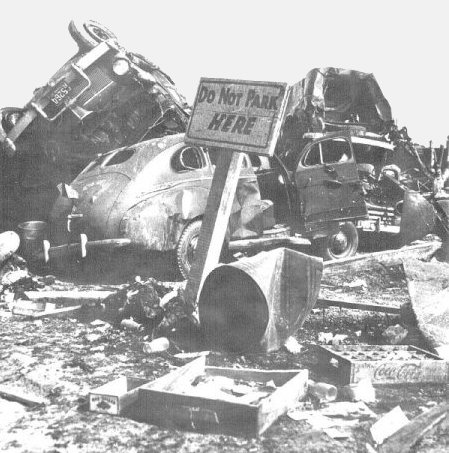
Sign Still Stands
A queer quirk of the Texas City explosion was found by Johnny Hendrickson, photographer
for The News, in a tour of the devastated area Thursday. Stacked like child's
tous are vehicles which were near the S. S. Grandcamp when it exploded Wednesday.
The sign, left standing in the foreground is ironical. The vehicle, top right,
was a Texas City ambulance in which a nurse and driver met death. Top automobile
on left belonged to Father William Roach, killed when he rushed to the explosion
area to administer to the dying.
The horror was not
over yet. As help poured into Texas City, no one gave much thought to another
Liberty ship tied up in the adjoining slip. The High Flyer was loaded
with sulfur as well as a thousand tons of ammonium nitrate fertilizer. The force
of the Grandcamp's explosion had torn the High Flyer from its
moorings and caused it to drift across the slip, where it lodged against another
vessel, the Wilson B. Keene. The High Flyer was severely damaged,
but many of its crew members, although injured, remained on board for about
an hour until the thick, oily smoke and sulfur fumes drifting across the waterfront
forced the master to abandon ship. Much later in the afternoon, two men looking
for casualties boarded the High Flyer and noticed flames coming from
one of the holds. Although they reported this to someone at the waterfront,
several more hours passed before anyone understood the significance of this
situation, and not until 11:00 P.M. did tugs manned by volunteers arrive from
Galveston to pull the burning ship away from the docks. Even though a boarding
party cut the anchor chain, the tugs were unable to extract the ship from the
slip. By 1:00 A.M. on 17th April, flames were shooting out of the hold. The
tugs retrieved the boarders, severed tow lines, and moved quickly out of the
slip. Ten minutes later, the High Flyer exploded in a blast witnesses
thought even more powerful than that of the Grandcamp. Although casualties
were light because rescue personnel had evacuated the dock area, the blast compounded
already severe property damage. In what witnesses described as something resembling
a fireworks display, incandescent chunks of steel which had been the ship arched
high into the night sky and fell over a wide radius, starting numerous fires.
Crude oil tanks burst into flames, and a chain reaction spread fires to other
structures previously spared damage. When dawn arrived, large columns of thick,
black smoke were visible thirty miles away. These clouds hovered over Texas
City for days until the fires gradually burned out or were extinguished by weary
fire-fighting crews.
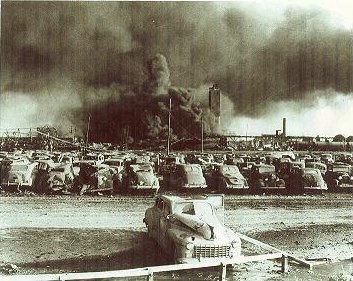
Another parking
lot, no vehicles were spared |
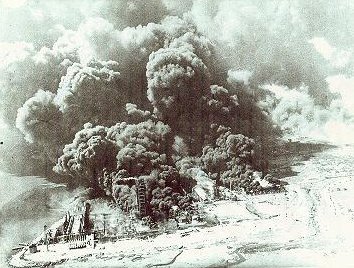
Ground zero on other
side of fire and smoke |
The Grandcamp's
explosion triggered the worst industrial disaster, resulting in
the largest number of casualties, in American history. Such was
the intensity of the blasts and the ensuing confusion that no
one was able to establish precisely the number of dead and injured.
Ultimately, the Red Cross and the Texas Department of Public Safety
counted 405 identified and 63 unidentified dead. Another 100 persons
were classified as "believed missing" because no trace
of their remains was ever found. Estimates of the injured are
even less precise but appear to have been on the order of 3,500
persons. Although not all casualties were residents of Texas City,
the total was equivalent to a staggering 25 percent of the towns
estimated population of 16,000. Aggregate property loss amounted
to almost $100 million, or more than $700 million in todays monetary
value. Even so, this figure may be to low, because this estimate
does not include 1.5 million barrels of petroleum products consumed
in flames, valued at approximately $500 million in 1947 terms.
Refinery infrastructure and pipelines, including about fifty oil
storage tanks, incurred extensive damage or total destruction.
The devastated Monsanto plant alone represented about $ 20 million
of the total. Even though the port's break-bulk cargo-handling
operations never resumed, Monsanto was rebuilt in little more
than a year, and the petrochemical industry recovered quickly.
One-third of the town's 1,519 houses were condemned, leaving 2,000
persons homeless and exacerbating an already-serious postwar housing
shortage. Over the next six months, displaced victims returned
as houses were repaired or replaced, and most of those who suffered
severe trauma appear to have recovered relatively quickly. What
could never be made good was the grief and bleak future confronting
more than 800 grieving widows, children, and dependent parents.
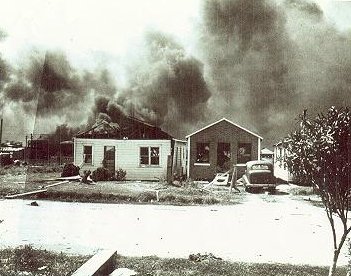
House fire caused
by explosion |
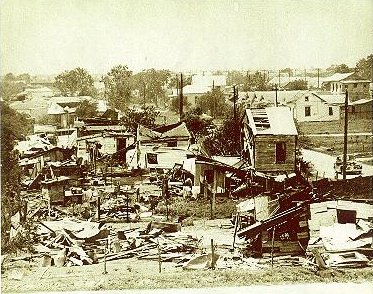
City blocks destroyed |
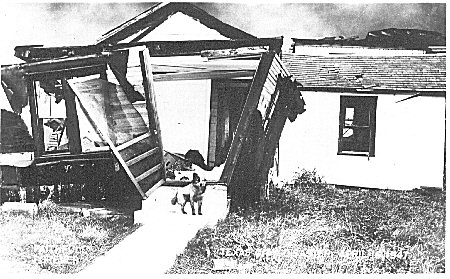 This dog
like many animals waited for thier owners who may never return.
This dog
like many animals waited for thier owners who may never return.
The burial service for the unidentified
dead was held Sunday morning, June 22, 1947 at 10:00 A.M. Despite the fact that
there was very little advance publicity, cars were park a mile and a half up
and down the highway, and the crowd was estimated at 5,ooo. The sixty-three
caskets were brought from Camp Wallace by separate hearses from fifty-one participating
funeral homes in twenty-eight cities. It was a striking procession, probably
the longest in the history of funeral services. Each casket was carried by pallbearers
from the American Legion, V.F.W., Labor Organizations and Volunteer Firemen.
Each was decorated with a spray of flowers, gifts of the Florist Association.
In this small plot of ground, at the time of the service only a scarred prairie,
were placed the remains of sixty-three unidentified dead, each in its own casket,
each in its own lined grave~numbered and recorded so that if a new inquiry were
ever necessary the information would be available. No one else ever has ever
been buried in this cemetery; no one else ever will be. It stands as a resting
place for those unidentified, and a memorial for all those who suffered during
that time.
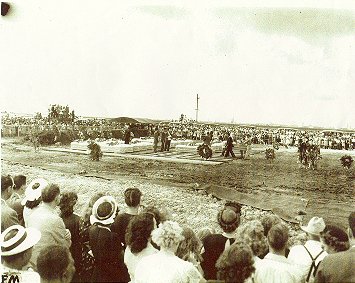 Funeral service, over 5,000
attended
Funeral service, over 5,000
attended |
The Memorial Cemetery in Texas
City is located on the northern edge of town, where Loop 197 joins Twenty-Ninth
Street. It still resembles the 1947 landscape design by Houston artist Herbert
Skogland but is not identical to it. Before the 1991 enlargement it was a grassy
plot, roughly two acres in size and surrounded by a stone wall. It was presided
over by an angel of Italian marble. The stone pillars on either side of a wrought
iron gate were simply inscribed "Memorial Cemetery Texas City 1947."
Inside remains a rectangular grassy lot with a oval pathway inside. In the pool,
in a small concrete circle, stands the marble angel, her eyes downcast and her
fingers perpetually strewing a marble flower. The base is inscribed "Texas
City Volunteer Firemen."
The bodies were buried in three
neat rows on either side of the pool, inside the oval. Each site was originally
marked with a piece of granite bearing a number which links it to a paper listing
everything known about the human being who lies there. In the years between
1947 and 1991 when the cemetery was enlarged and refurbished as a WAR AND PEACE
MEMORIAL, many of the small markers were lost, moved, or buried in the thatch
grass. When the cemetery was enlarged, the remaining markers were relocated
within a brick wall. Thus, it is that now the remains are truly anonymous, known
only to God.
Who then is buried in the little cemetery? No one will ever no for certain,
but among the missing are nineteen members of the Volunteer Fire Department,
thirty-one members of the crew of the Grandcamp, and several school children
who had been on the pier watching the fire. Also among the missing are Victor
Wehmeyer, the funeral director; H.J. Mikeska, President and General Manager
of the Texas City Terminal Railway; longshoremen; employees of Monsanto, Republic,
and the Texas City Terminal; sightseers; and others whose fate it was to be
in the plant or on the dock that day.
Read
the Texas City, Texas, Disaster Report.
This report was put out on April 29, 1947, 13 days after the first explosion
and is complete with photographs.
Monsanto Letter pertaining to a check written for membership dues to the Texas City Volunteer Fire Dept.
The Link below has 100's of disaster photographs that are currently being digitalized. These were photographs that are stored in the Moore Memerial Library.
Texas City Disaster Online Exhibit
A Portal To Texas History
The Grandcamp's plaque
and anchor pictured below as well as the propeller are what I took around Texas
City. They will always be just a part of the reminder of what took place that
fateful day on April 16, 1947.
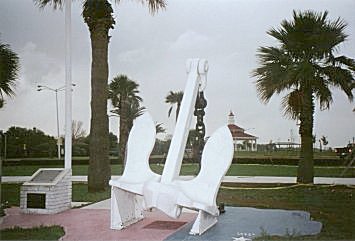
Another anchor from
Grandcamp now located at entrance to the Dike |
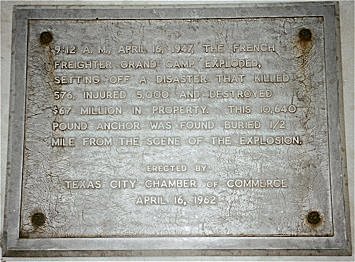
Plaque located to
left of anchor |
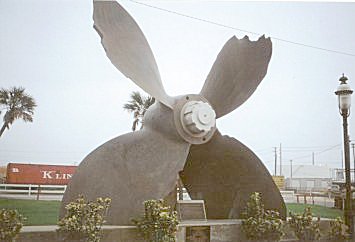
Propeller from the
Highflyer located at the Texas City Terminal Railway |

Plaque located beneath
propeller |
Texas City
Volunteer Badge
Most likely Pre-Disaster dated
Shane Martin B-Shift is current owner
The names of the 28 Texas City Firefighters who lost
thier lives when the Ship exploded.
This Plaque is located at Fire Station 2
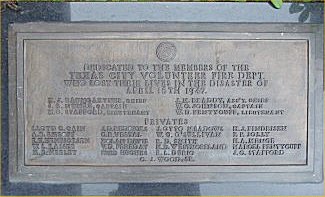
|
HENRY J. BAUMGARTNER
"FIRE CHIEF"
|
JOSEPH MILTON BRADDY
"ASS'T CHIEF"
|
|
SEBASTAIN B. NUNEZ
"CAPTAIN"
|
WILLIAM CARL JOHNSON
"CAPTAIN
|
|
MARSHALL B. STAFFORD
"LIEUTENANT"
|
WILLIAM D. PENTYCUFF
"LIEUTENANT"
|
|
|
"PRIVATES"
WILLIAM C. O'SULLIVAN
|
|
ROY LOUIS DURIO
|
MARCEL PENTYCUFF
|
|
ARCHIE BOYCE EMSOFF
|
HARVEY ALONZO MENGE
|
|
HENRY JOHN FINDEISEN
|
JIMMY REDDICKS
|
|
VIRGIL D. FEREDAY
|
ROBERT DEE SMITH
|
|
EDWARD HENRY HENRICKSEN
|
JOEL CLIFTON STAFFORD
|
|
WILLIAM FRED HUGHES
|
MAURICE R. NEELY
|
|
LLOYD GEORGE CAIN
|
MARION D. WESTMORELAND
|
|
FRANK P. JOLLY
|
CLARENCE J. WOOD
|
|
WILLIAM LOUIS KAISER
|
CLARENCE ROME VESTAL
|
|
JACOB OTTO MEADOWS
|
|
Lest
We Forget
Those Dead and Missing As a Result of the Disaster of April
16, 1947

Chief Baumgartner
Click picture for larger view
These are 2 badges that belonged to Chief Baumgartner. They are now back with the family of Michael Baumgertner. Michael is Chief Baumgartners Grandson.
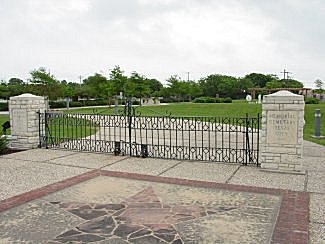
Through these gates you will see more plaques in dedication to the victims of
the blast.
Click gates to enter.
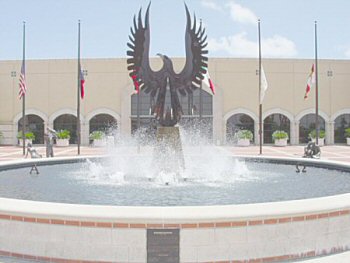
The
Phoenix Fountain
Personal
Experience of Jim Bell, Patrolman, Texas City Police Department
Please click above for story
Pictures from the Yoas Family
Pictures from the Chauvin Family
Pictures from the Rothenberger Family
Pictures from Garland Sims
Pictures from the Farley Family
All information for this story
was obtained from the Moore Memorial Public Library, Texas City.
"We Were
There"
Click
here to read the Poem by MaryAnn Maddux
In 1997, the City of Texas
City, both the elected leadership and volunteer citizens, planned to observe
the Fifthieth Anniversary of the Texas City Disaster in a meaningful way
that would both commemorate the event and celebrate the City's recovery
and progress over the past fifty years. One aspect of that multi-faceted
commemoration involved the collection of personal experiences from living
survivors.
It was initially thought that perhaps two to three hundred stories might
be recieved and that each story could be included in its entirety. In fact,
over eight hundred stories were collected. Most were handwritten by the
survivor or told to a friend or family member. Others took the form of an
oral history project. This book is a compilation of those stories. It is
not meant to be a scholarly work, but a collection of personal reminiscences.
Due to the large number of stories recieved, it was reluctantly determined
that the stories must be edited for length if all were to be included. In
the process, every effort was made to preserve the essential content of
each story and the words of the writer. The original, unedited stories are
on file in the Mainland Museum of Texas City, available to all who might
wish to see them.
Although some of the material may appear inconsistent or inaccurate in detail,
each account is personal, told from an individual point of view and frame
of reference. And so, this book is more about hearts and feelings and lives
than it is about history, and tells the story in a way in which it has never
been told before. These accounts from the 1947 disaster in Texas City present
a wide range of experiences. They are now memories filtered through years
of time, with points of view colored by each person's thoughts and emotional
reactions. Therefore it is appropriate to begin with a brief, historical
narrative outlining the events leading up to the disaster, the explosions
themselves, and the relief efforts afterwards so that the reader might have
a setting against which these hundreds of small dramas could be played.
(the story above with pictures) Perhaps some reader in future years may
not know about Texas City, or what happened there. It is for that reader
that this brief background and the section on the Rebirth celebration are
included.
Most of all, taken in its entirety, this is the story of the triumph of
the human spirit over seemingly limitless catastrophe.
I will change the stories out
once a month so as to show all the different and unique stories.
|
BIEGERT, LYDIA EISENHAUER
I had spent three years working in John Sealy Hospital's emergency room, but it didn;t prepare me for the realities of the Texas City Disaster. We had inadequate supplies and before long limited amounts of anesthetics. It was my day off, and someone said Texas City had an explosion. Anyone not assigned to duty that day was to dona uniform and report for further assignment. I dressed, skipped breakfast and dahsed to the step of "Old Red."
A senior physician loaded several medical students and me into his car and raced acrossed the causeway.
We drove by burning storage tanks
while smoke-blackened men in hard hats battles the flames along the road.
It was like newsreel shown of European cities during World War II. We drove down 6th Street and stopped at different clinics and first aid stations. At each stop a medical student got out.
My turn came at Beeler-Mankse Clinic.
I was assigned to a small operating room, where tonsils and adenoids were done. At least those were the type of instruments a senior medical student and I had to work with in there. Our patients were young children from a nearby school who had cuts from flying glass. We cleaned, sutured and bandaged, without benefit of anesthetic, a never ending stream of injured children. Most of them were conscious, but I don;t recall any of them crying. Eventually, we were evicted when a really serious injured adult male was placed on the table and "real" doctors and nurses took over.
That was the last of my dealings with disaster victims, but April 16, 1947, like December 7, 1941, is engraved in my memory.
|
BIGGS, GEORGE L.
My parents, George and Doris, were taking me for an eye exam and new glasses. Dad showed us the orange glow over the docks from our dining room window. He had worked there prior to working at the tin smelter and said we might have to drive by to see what was happening. Mother said we didn't have time. Sister Bonnie Jean was at school. My mother, brothers, Luckie and Paul, Dad and I were enroute to Galveston on 6th Street near 9th Avenue when the exposion occurred. Dad said it felt like someone had slapped him in the face as hard as they could. He put us out and told us to run home and wait for him while he got Bonnie.
There was an odor in the air. While working at Monsanto years later, I smelled that same odor again around the styrene unit. When we reached our home on 19th Avenue, people were running through the prairie in front of our home, fleeing the fires. We all believed the city was going to blow up. My grandparenst met us at our house, and when Dad and Bonnie returned, we all left for Dickinson, but Dad would not go with us. He said he had to go to the docks to help.
He came to get us that evening at the Catholic Church, which gave refuge to all who needed it. We went back home to straighten things up. We heard a police car loudspeaker warning everyone to leave Texas City. Another ship explosion was imminent. Dad kept on hammering. A policeman came to our front door for the second time and stayed until we left.
We went back to Dickinson church. Dad slept for awhile, then returned to the docks to help out.
Next morning the Army took us to Camp Wallace, fed us and took care of our needs. After afew days, Dad took us home. Our family of relatives were very fortunate, as we suffered no deaths and only minor injuries.
We lost some good neighbors, friends and fellow townsmen. |
Click below to read past stories that were posted.
Past Stories
I have added a whole new page
of pictures that were loaned to me for this site. Please click below to view
more pictures of the disaster taken when the Houston Fire Department came
into town to help.
MORE
PICS HERE
Click
here to see the 57th Disaster Memorial Service held on April 16, 2004
LIFE Article 1947
TEXAS CITY REMEMBERS
1948
There are three excellent books out on The Texas City
Disaster. Please click below for information on these books.
BOOKS
The History Channel periodically runs the story of the Disaster titled "Wrath
of God: Texas City Explosions." You can click HERE
to purchase the video. If you want to see what happened on that fateful day
back in 1947 this is a must see video.
A donated Fire truck 1947
This page is
in memory of all those that lost their lives during the Disaster, the Firefighters
who fought in vain to extinguish the fire, the Grand Camp's Crewmembers who
never made it home, the people of Texas City that went down to look at the
beautiful orange smoke against a clear blue sky only to find tragedy and death,
the family members who lost their loved ones, the survivors who with courage
and determination rebuilt a city that was virtually destroyed and for those
who wish to learn about what happened so we will never forget.
..........................................................................................Mark
Pandanell
Many thanks to
Suzie Moncla at the Moore Memorial Library for all her help.
This page was
created by Mark Pandanell of the Texas City Fire Department.
Texas
City Firefighters
Texas
City Website
If anyone has
any information or photos not seen here please contact me at the Email below.



